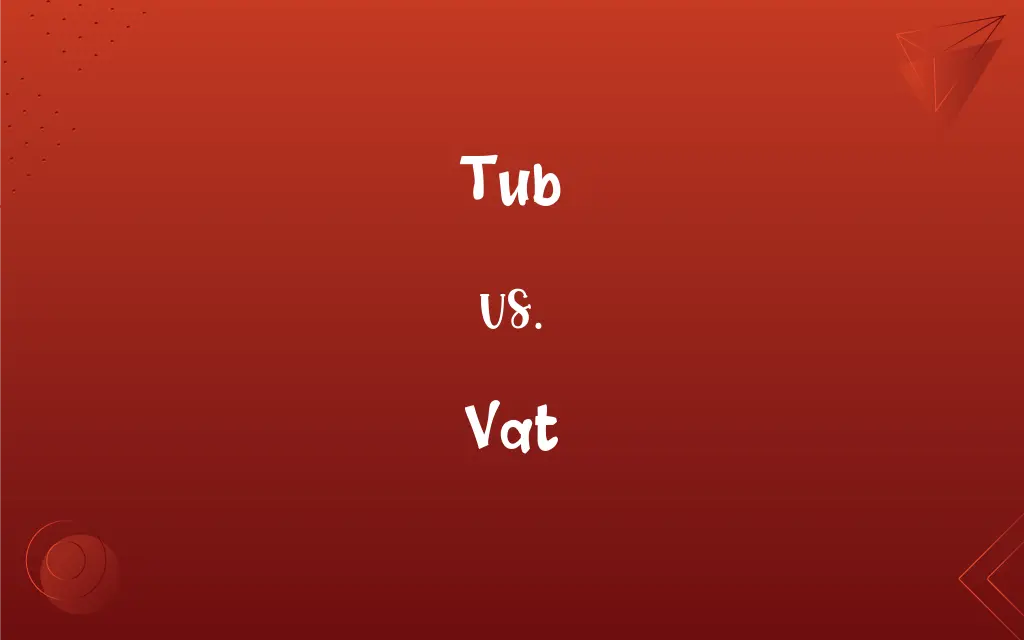Tub vs. Vat: What's the Difference?
By Harlon Moss & Janet White || Updated on May 20, 2024
A tub is a relatively small, open container typically used for bathing, washing, or holding liquids, while a vat is a large container used primarily for industrial processes or storing large quantities of liquids or substances.

Key Differences
A tub is a medium-sized container, often found in households, used for purposes like bathing, washing clothes, or holding liquids. It is generally portable and made of materials such as plastic, metal, or ceramic. In contrast, a vat is a large container used in industrial or commercial settings for processes such as fermenting, dyeing, or storing large quantities of liquids. Vats are usually made from durable materials like stainless steel, wood, or plastic to handle substantial volumes and various substances.
Tubs are typically used for personal or domestic activities, where their size and portability are advantageous. They serve everyday needs and are commonly found in homes. Vats, on the other hand, are designed to handle industrial-scale tasks, where their large capacity and robust construction are essential. They are integral to manufacturing processes, including brewing, winemaking, and chemical production.
While tubs are versatile and found in many settings, from bathrooms to gardens, vats are more specialized and seen in factories, breweries, and other large-scale operations. The key difference lies in their size, usage context, and construction materials, reflecting their distinct roles in personal versus industrial applications.
Comparison Chart
Size
Medium-sized
Large
Usage Context
Personal, domestic
Industrial, commercial
ADVERTISEMENT
Common Materials
Plastic, metal, ceramic
Stainless steel, wood, durable plastics
Typical Uses
Bathing, washing, holding liquids
Fermenting, dyeing, storing large quantities
Portability
Generally portable
Typically stationary
Examples
Bathtub, laundry tub, storage tub
Fermentation vat, dyeing vat, brewing vat
Tub and Vat Definitions
Tub
A medium-sized, open container used for washing or bathing.
She filled the tub with warm water for a relaxing bath.
ADVERTISEMENT
Vat
A container for holding large quantities of liquids or substances.
The chemical factory had several vats for different reactions.
Tub
A container for holding liquids or other substances.
The gardener used a tub to carry water to the plants.
Vat
A robust container designed for commercial use.
The brewery used stainless steel vats for brewing beer.
Tub
A portable container for domestic use.
They kept toys in a plastic tub in the playroom.
Vat
A container that is typically stationary due to its size.
The fermentation vat had to be cleaned and sterilized before use.
Tub
A container that can be used in different settings, such as kitchens or bathrooms.
She used a large tub to mix ingredients for the cake.
Vat
A large container used in industrial processes.
The winery stored the wine in oak vats for aging.
Tub
An open, flat-bottomed vessel, usually round and typically wider than it is deep, used for washing, packing, or storing.
Vat
A large vessel, such as a tub, cistern, or barrel, used to hold or store liquids.
Tub
The amount that such a vessel can hold.
Vat
To put into or treat in a vat.
Tub
The contents of such a vessel.
Vat
A large tub, such as is used for making wine or for tanning.
A vat of liquid
A vat of acid
A vat of wine
A vat of olives
A vat of fat
A vat of glue
Tub
A bathtub.
Vat
A square, hollow place on the back of a calcining furnace, where tin ore is laid to dry.
Tub
(Informal) A bath taken in a bathtub.
Vat
(Roman Catholic) A vessel for holding holy water.
Tub
(Informal) A wide, clumsy, slow-moving boat.
Vat
(dated) A liquid measure and dry measure; especially, a liquid measure in Belgium and Holland, corresponding to the hectolitre of the metric system, which contains 22.01 imperial gallons, or 26.4 standard gallons in the United States.
Tub
A bucket used for conveying ore or coal up a mine shaft.
Vat
(transitive) To put into a vat.
Tub
A coal car used in a mine.
Vat
(transitive) To blend (wines or spirits) in a vat; figuratively, to mix or blend elements as if with wines or spirits.
Tub
To pack or store in a tub.
Vat
A large vessel, cistern, or tub, especially one used for holding liquors in an immature state, chemical preparations for dyeing, or for tanning, or for tanning leather, or the like.
Let him produce his vats and tubs, in opposition to heaps of arms and standards.
Tub
To wash or bathe in a tub.
Vat
A measure for liquids, and also a dry measure; especially, a liquid measure in Belgium and Holland, corresponding to the hectoliter of the metric system, which contains 22.01 imperial gallons, or 26.4 standard gallons in the United States.
Tub
To take a bath.
Vat
A wooden tub for washing ores and mineral substances in.
Tub
A flat-bottomed vessel, of width similar to or greater than its height, used for storing or packing things, or for washing things in.
He bought a tub of lard to roast the potatoes in.
Vat
A vessel for holding holy water.
Tub
The contents or capacity of such a vessel.
She added a tub of margarine to the stew.
Vat
To put or transfer into a vat.
Tub
A bathtub.
Vat
A tax levied on the difference between a commodity's price before taxes and its cost of production
Tub
A slow-moving craft.
Vat
A large open vessel for holding or storing liquids
Tub
Any structure shaped like a tub, such as a certain old form of pulpit, a short broad boat, etc.
Vat
An industrial-sized container for specific manufacturing tasks.
The dyeing vat was used to color batches of fabric.
Tub
A small cask.
A tub of gin
Tub
Any of various historically designated quantities of goods to be sold by the tub (butter, oysters, etc).
Tub
(mining) A box or bucket in which coal or ore is sent up a shaft.
Tub
(obsolete) A sweating in a tub; a tub fast.
Tub
(slang) A corpulent or obese person.
Tub
(transitive) To plant, set, or store in a tub.
To tub a plant
Tub
(ambitransitive) To bathe in a tub.
Tub
An open wooden vessel formed with staves, bottom, and hoops; a kind of short cask, half barrel, or firkin, usually with but one head, - used for various purposes.
Tub
The amount which a tub contains, as a measure of quantity; as, a tub of butter; a tub of camphor, which is about 1 cwt., etc.
Tub
Any structure shaped like a tub: as, a certain old form of pulpit; a short, broad boat, etc., - often used jocosely or opprobriously.
All being took up and busied, some in pulpits and some in tubs, in the grand work of preaching and holding forth.
Tub
A sweating in a tub; a tub fast.
Tub
A small cask; as, a tub of gin.
Tub
A box or bucket in which coal or ore is sent up a shaft; - so called by miners.
Tub
To plant or set in a tub; as, to tub a plant.
Tub
To make use of a bathing tub; to lie or be in a bath; to bathe.
Don't we all tub in England ?
Tub
A relatively large open container that you fill with water and use to wash the body
Tub
A large open vessel for holding or storing liquids
Tub
The amount that a tub will hold;
A tub of water
Tub
A household item used for various purposes.
The laundry tub was full of clothes soaking in soapy water.
FAQs
What materials are tubs made from?
Tubs are typically made from plastic, metal, or ceramic.
What is a vat?
A vat is a large container used in industrial processes or for storing large quantities of substances.
Are vats portable?
No, vats are typically stationary due to their large size.
Are tubs portable?
Yes, tubs are generally portable.
What is a tub?
A tub is a medium-sized container used for bathing, washing, or holding liquids.
Can a vat be used in domestic settings?
Vats are usually too large and impractical for domestic settings.
Where are vats commonly used?
Vats are used in industrial settings such as factories, breweries, and wineries.
What is an example of a vat?
A fermentation vat used in winemaking is an example of a vat.
Where are tubs commonly used?
Tubs are commonly used in households for bathing, laundry, and storage.
Are tubs used for storage?
Yes, tubs can be used for storing various items.
What materials are vats made from?
Vats are usually made from stainless steel, wood, or durable plastics.
Can a tub be used in industrial settings?
Tubs are not typically used in industrial settings due to their smaller size and capacity.
Do tubs have a specific shape?
Tubs can vary in shape but are generally medium-sized and open.
Do vats have a specific shape?
Vats are usually large and cylindrical to maximize capacity and efficiency in industrial processes.
Can tubs be found in kitchens?
Yes, tubs can be used in kitchens for mixing and holding ingredients.
What is an example of a tub?
A bathtub used for bathing is an example of a tub.
Are vats used for storage?
Yes, vats are used for storing large quantities of liquids or substances.
Can vats be found in breweries?
Yes, vats are commonly used in breweries for brewing beer.
What is the primary use of a tub?
The primary use of a tub is for personal or domestic activities like bathing and washing.
What is the primary use of a vat?
The primary use of a vat is for industrial processes and large-scale storage.
About Author
Written by
Harlon MossHarlon is a seasoned quality moderator and accomplished content writer for Difference Wiki. An alumnus of the prestigious University of California, he earned his degree in Computer Science. Leveraging his academic background, Harlon brings a meticulous and informed perspective to his work, ensuring content accuracy and excellence.
Co-written by
Janet WhiteJanet White has been an esteemed writer and blogger for Difference Wiki. Holding a Master's degree in Science and Medical Journalism from the prestigious Boston University, she has consistently demonstrated her expertise and passion for her field. When she's not immersed in her work, Janet relishes her time exercising, delving into a good book, and cherishing moments with friends and family.































































